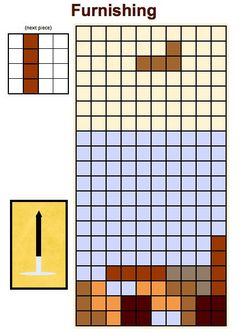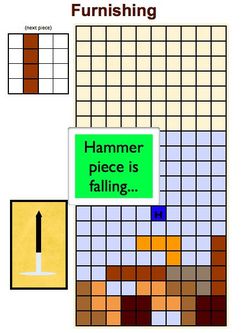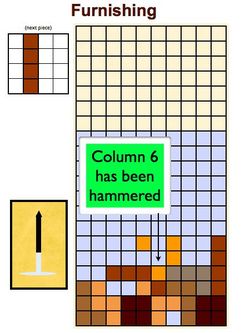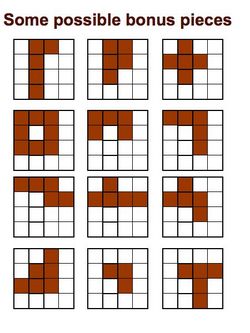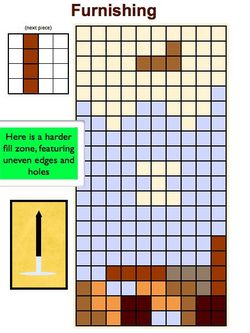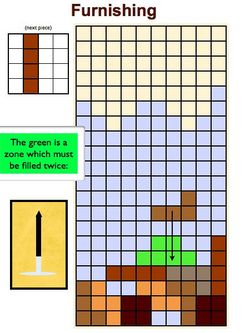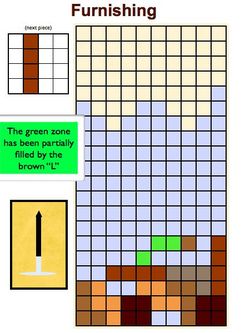GCPP:Proposal-Sargo
Puzzle Codename: Sargo
| Contact | |
| Username: | llamapalooza |
| Additional contact info: | Llamason on Viridian; (myusername)87@gmail.com |
| Project forum thread: | http://forums.puzzlepirates.com/community/mvnforum/viewthread?p=1542898#1542898 |
Game concept
Similar to Tetris, but with the goal of filling the board instead of keeping it clear.
Objective
Use the pieces to fill in the "fill zone" as completely as possible.
Gameplay
The game takes place on a 10x20 grid of somewhat small squares. Tetraminoes--wood-- fall from the top-center of the screen toward the "fill zone." Players move these pieces left and right, and rotate them 90˚ Clockwise or Counter-clockwise. When the piece falls into place touching another piece or the ground, it locks into place. The pieces stack up in this manner. Unlike in Tetris, blocks never clear; a full line is beneficial but does not free up space. The player's goal is to fill up the fill zone as completely as possible. The player is not timed, but the gravity on the pieces would force the player to act before the piece hits the ground.
Scoring
A player's score would be based on the percentage of the fill zone filled in. Players would lose 1 block's worth of points for every block placed outside the fill area (though there could be three or so "freebies" before any deductions occurred).
This would be indicated on the side of the screen with a nail which fills in vertically as more pieces are placed.
Variability
The player would encounter the highly variable change in piece patterns typical of a random block-dropping game. The player could also encounter special blocks:
Either after a set number of pieces, or after a player earns it via an as-of-yet-unknown condition, a hammer would appear. This very helpful 1x1 piece shifts into place the entire column beneath it, filling in any gaps.
At higher difficulties, non-standard pieces will occasionally appear. These could include pentaminoes, or even more complex pieces such as a 3x3 square with no center piece.
The fill zone will not always be a perfect rectangle; the top could be shaped differently, perhaps representing a leg of a table which must snap into the table's base. Middle portions of the fill zone could be left blank, as well, perhaps representing drawers. Knobs, or feet, or thicker portions of the furniture, could be created by making a region of the fill zone differently-colored, which must be filled twice (i.e., any pieces or portions of pieces inside that zone will disappear and revert its position to a standard fill zone).
The player chooses when to end the board, allowing him/her to decide whether to attempt to "wait out" the piece(s) he/she needs or end the game without placing unnecessary pieces.
End criteria
The game ends if the fill zone is completely filled or blocked off, or when no more pieces can enter the grid because of blockage, or when the player presses a button indicating he/she is satisfied with the current fillage.
Difficulty scaling
On higher difficulties, pieces would fall faster. On higher difficulties, fill zones would be more irregular. On the second difficulty, the hammer would appear. On the third difficulty, some of the pentaminoes would appear. On the fourth difficulty, all of the pentaminoes would appear. On the highest difficulty, the "obnoxious" pieces like the 3x3 block would rarely appear.
Crafting type
Furnishing
Known problems
Too little room for what I call "showboating"-- making an intricate, but risky, plan, and getting a higher score than someone who simply fills the board without any flashiness. I personally like this straightforwardness, but it seems a bit removed from traditional YPP! designs.
Some may see it as too derivative of Tetris, while others may see it as too far removed from Tetris.
Notes
There is a whole lot of room for suggestion here, so I encourage you to help me out! Ideas for special pieces and how to obtain the hammer are especially appreciated.
Images
